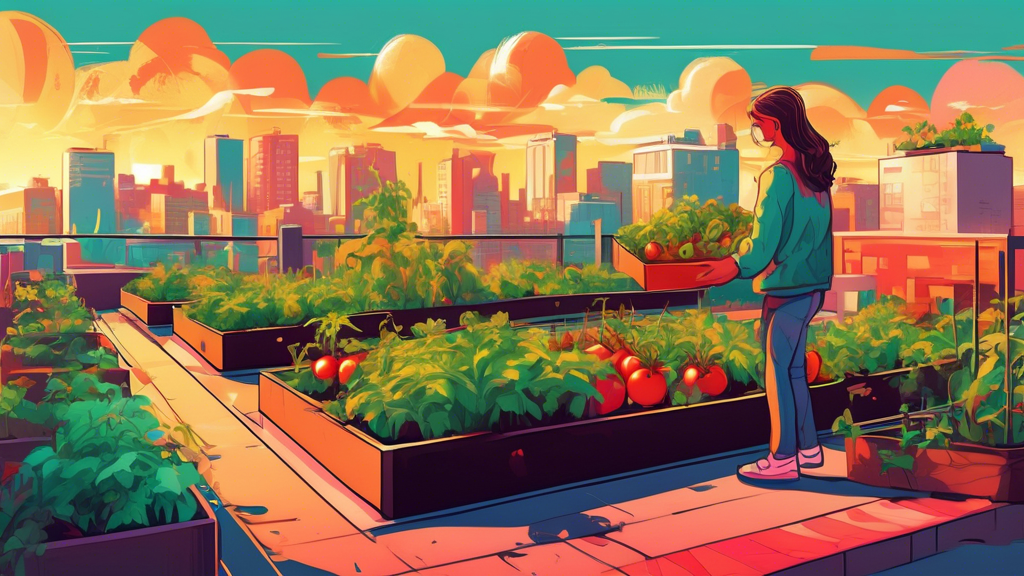What is Urban Gardening?
Urban gardening is the practice of growing plants, whether edible or ornamental, in an urban environment. It encompasses various methods, from container gardening on balconies to community plots and vertical gardens. It’s a fantastic way to reconnect with nature, enjoy fresh produce, and add a touch of green to concrete jungles.
Why Urban Gardening Matters
Beyond the aesthetic appeal, urban gardening offers a wealth of benefits:
- Environmental Impact: Urban gardens combat air pollution, reduce urban heat islands, and promote biodiversity by attracting beneficial insects and pollinators.
- Food Security: Growing your own food increases access to fresh, healthy produce, especially in areas where grocery stores are scarce or unaffordable.
- Community Building: Community gardens foster social interaction, shared knowledge, and a sense of belonging among residents.
- Mental and Physical Well-being: Gardening is a therapeutic activity that reduces stress, improves mental clarity, and provides physical exercise.
Getting Started with Urban Gardening: A Step-by-Step Guide
1. Assessing Your Space and Resources
Before diving in, take stock of your urban environment:
* Sunlight: Observe how much direct sunlight your space receives throughout the day. Most edible plants thrive in at least 6 hours of sunlight.
* Space: Whether it’s a balcony, rooftop, windowsill, or a small patch of yard, determine the available space and choose gardening methods accordingly.
* Water Access: Ensure you have easy access to water for your plants, especially during hot summer months.
* Budget: Set a realistic budget for essential supplies like containers, soil, plants, and tools.
2. Choosing the Right Gardening Method
Urban gardening offers diverse methods to suit different spaces and preferences:
* Container Gardening: Ideal for balconies, patios, and rooftops. Choose containers with good drainage and use potting mix specifically designed for containers.
* Raised Beds: Great for small yards or areas with poor soil. You can build raised beds with wood, brick, or purchase ready-made kits.
* Vertical Gardening: Maximize vertical space with trellises, wall-mounted planters, or living walls for climbing plants, herbs, and strawberries.
* Hydroponics and Aquaponics: These soil-less gardening methods are ideal for limited spaces and offer faster growth rates. They require specific equipment and knowledge.
* Community Gardens: Join a local community garden to access larger plots, shared resources, and a supportive network of fellow gardeners.
3. Selecting What to Grow
Choose plants that are well-suited to your climate, available sunlight, and personal preferences:
* Easy-to-Grow Vegetables: Tomatoes, lettuce, spinach, peppers, zucchini, and herbs are excellent choices for beginners.
* Fruits for Small Spaces: Strawberries, blueberries, and dwarf fruit trees thrive in containers.
* Vertical Delights: Climbing beans, cucumbers, grapes, and tomatoes make the most of vertical spaces.
* Pollinator-Friendly Flowers: Attract bees, butterflies, and other beneficial insects with lavender, sunflowers, marigolds, and zinnias.
4. Soil and Compost: The Foundation of Your Garden
Healthy soil is paramount for plant growth. Opt for these options:
* High-Quality Potting Mix: For containers, choose a lightweight, well-draining potting mix rich in nutrients.
* Soil Testing: If using existing garden soil, get it tested to determine its pH level and nutrient content.
* Composting: Start a compost bin to recycle kitchen scraps and yard waste into nutrient-rich fertilizer.
5. Watering and Drainage
Proper watering is crucial. Consider these factors:
* Container Drainage: Ensure containers have drainage holes to prevent waterlogging.
* Watering Frequency: Water deeply when the top inch of the soil feels dry. Avoid overwatering, which can lead to root rot.
* Watering Methods: Use a watering can, soaker hose, or drip irrigation system for efficient watering.
6. Sunlight Requirements
Understand the sunlight needs of your chosen plants:
* Full Sun: At least 6 hours of direct sunlight per day.
* Partial Shade: 4-6 hours of direct sunlight, preferably in the morning.
* Shade: Less than 4 hours of direct sunlight or filtered sunlight throughout the day.
7. Providing Essential Nutrients
Replenish soil nutrients with these methods:
* Organic Fertilizers: Compost, worm castings, and aged manure provide slow-release nutrients.
* Balanced Fertilizers: Use a balanced liquid or granular fertilizer according to package instructions.
* Nutrient Deficiencies: Watch for signs of nutrient deficiencies in plants, like yellowing leaves, and adjust fertilization accordingly.
8. Pest and Disease Control
Urban gardens can be susceptible to pests and diseases. Implement these preventative measures:
* Companion Planting: Certain plant combinations deter pests. For example, marigolds repel aphids.
* Beneficial Insects: Attract ladybugs, lacewings, and praying mantises, which are natural predators to many garden pests.
* Organic Pest Control: Use neem oil, insecticidal soap, or diatomaceous earth to manage pest infestations.
* Crop Rotation: Rotating crops each season helps break pest and disease cycles.
9. Maintaining Your Urban Garden
Regular maintenance ensures a thriving garden:
* Weeding: Remove weeds regularly to prevent competition for nutrients and sunlight.
* Pruning: Trim dead or diseased branches to promote healthy growth and airflow.
* Harvesting: Harvest fruits and vegetables at their peak ripeness for the best flavor.
10. Enjoying the Fruits (and Vegetables!) of Your Labor
The most rewarding part of urban gardening is enjoying the fruits of your hard work. Harvest your produce, savor the flavors, and share the abundance with friends and neighbors.
Urban Gardening: Resources for Further Exploration
Numerous resources are available to support your urban gardening journey:
* Local Garden Centers and Nurseries: Seek advice from experts, find suitable plants, and gather supplies.
* Community Gardens: Connect with fellow gardeners, participate in workshops, and gain hands-on experience.
* Online Resources: Explore gardening websites, blogs, and forums for tips, tricks, and inspiration.
Embrace the Urban Gardening Movement
Urban gardening is more than just a hobby—it’s a sustainable and rewarding way to transform urban spaces into green havens. By embracing this movement, you contribute to a healthier environment, foster a sense of community, and enjoy the satisfaction of growing your own food. So, grab your gardening gloves and embark on this fulfilling adventure—your urban oasis awaits!


